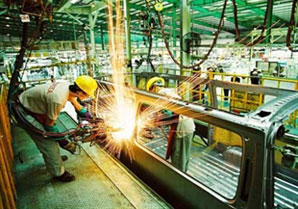Strength and resilience
In 2008, Vietnam’s FDI rose to record highs, with a commitment of US$64 billion and a disbursement of nearly US$12 billion. The average rate of FDI attraction was more than US$5.3 billion per month, the highest level so far.
But the committed amount dropped sharply in the first quarter of 2009 to just US$6 billion. Two quarters later the figure climbed to US$8.7 billion with US$4 billion disbursed.
Nonetheless, by late 2009, total attracted FDI had hit US$21.5 billion, including capital from new projects and additional capital from existing ones. The US led 43 countries and territories that invested in Vietnam.
For the year, the disbursement of US$10 billion from FDI projects somewhat offset the drop in registered FDI. On the whole, the FDI-related results remained high given the context of a global economic meltdown and declines in the world’s total FDI, says the Ministry of Planning and Investment.
Moreover, business operations of the FDI sector have rapidly recovered and helped the Vietnamese economy maintain a healthy growth rate of 5.32 percent. While the country suffered a trade deficit of US$12 billion, the FDI sector enjoyed a trade surplus of US$5 billion. The FDI sector fetched as much as US$29.9 billion from exports in 2009, accounting for 52.7 percent of the country’s total export value.
Challenges ahead
The decline in FDI in 2009 was mainly attributed to the global financial downturn but economic experts still underscore weaknesses inside the Vietnamese economy as major obstacles to FDI inflows. The problems include inconsistency in the legal systems, prolixity in investment policies and procedures, poor infrastructure and high input costs, a shortage of skilled human resources, and unprofessional FDI promotion.
Dr Le Dinh An, Director of the National Centre for Socio-economic Information and Forecast, warns that the recent global economic recession reflected internal imbalances in economies, including Vietnam, requiring greater attention to quality rather than quantity.
After a crisis, foreign investors tend to shift their investment structure and adjust their business strategies, posing another challenge for the Vietnamese economy. This was proved by the 2009 FDI structure, which saw a significant shift to the hospitality and restaurant services with a pledged FDI of US$8.8 billion (ranking first), followed by the real estate sector (US$7.6 billion). Processing and manufacturing industries came third with a capitalization of US$2.97 billion.
Economists recommend the country closely monitor these shifts and make swift and appropriate actions so as to seize emerging opportunities.
New opportunities
The world economy is expected to have a stronger impetus of recovery in 2010 than in 2009. Accordingly, FDI inflows should bounce back in the short term as investors become increasingly optimistic about medium- and long-term economic prospects.
But, Dr Le Dinh An says, FDI recovery in the coming time will be determined by additional factors such as the level of global economic growth, efficiency of aid policies, stability of financial systems and capacity of transnational companies.
Faced with this trend, Vietnam is thought to have a good chance to increase its FDI sources. Recent research by the UN Conference on Trade and Development (UNCTAD) shows that Vietnam is one of the 15 countries most highly praised for their investment climate and is considered an attractive destination for FDI in 2010. It is believed that the Vietnamese economy’s resilience will strengthen foreign investor confidence and boost the flow of FDI into Vietnam. The Vietnamese government’s policies on equitizing state-owned enterprises and on transforming the operation models of certain corporations and groups and its approval of the sale of certain businesses to foreign investors are very likely to accelerate FDI inflows.
The government plans to step up disbursement of committed FDI and to attract FDI into high-priority sectors and regions in a rational way.
It is expected that new registered FDI will rise to some US$19 billion in 2010, and additional capital from existing projects to about US$3 billion. This year’s total of FDI implemented is estimated to be between US$10-11 billion./.
 Although the global economic crisis slashed foreign direct investment (FDI) inflows into Vietnam in 2009, the country can regain its momentum of attracting FDI if it is well prepared, according to the National Centre for Socio-economic Information and Forecast.
Although the global economic crisis slashed foreign direct investment (FDI) inflows into Vietnam in 2009, the country can regain its momentum of attracting FDI if it is well prepared, according to the National Centre for Socio-economic Information and Forecast. 
 Previous page
Previous page Back to top
Back to top







